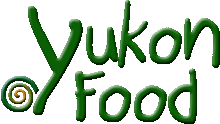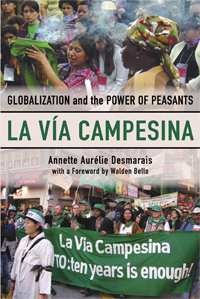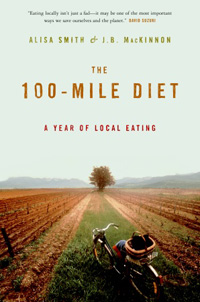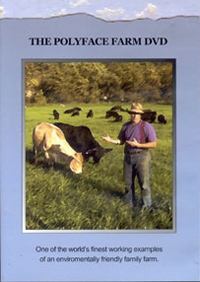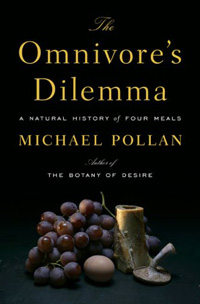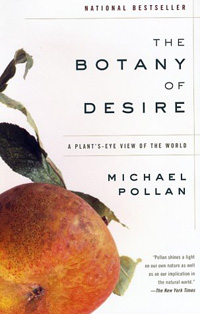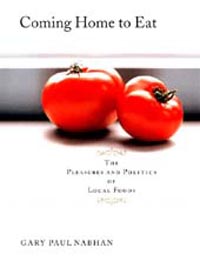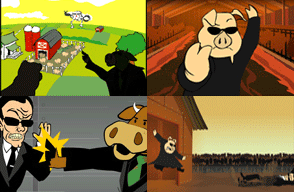|
Books and Videos P.O. Box 20228 |
| There is a lot of useful information available free of charge from the Yukon Public Libraries, the Energy Mines and Resources library, the Canadian Organic Growers library or on-line. Check out this collection of books... | |
|
Celebrate Yukon Food In this world, where we are both insular and global, sometimes you have to go all the way to Italy to meet your neighbours. I met Yukon farmer Joanne Jackson Johnson on our way to Terra Madre. It was on a bus ride from the mountain village of Susa to the city of Turin, that she slipped a copy of CelebrateYukon Food out of her bag and into my hands-very precious cargo indeed. I could see immediately that this book is an exception to the ‘you can’t judge a book by its cover’ rule, judging by its high quality production and just the right mix of imagery and fonts teasing me into its pages full of Yukon recipes, farm profiles, and artwork. I spent the rest of the bus ride reading. I toted the book around in my Terra Madre conference bag for months, sharing it with family, friends and the GO network, taking in their responses. Everyone-without exception-from hardcore farmers to culinary experts and Alberta’s best chefs said ‘this is a great book.’ Impressed by the layout and content, they probably did not notice the extraordinary attention to detail and thorough index. Overall, it is a very impressive package. No wonder it is in its third print run of 1000 copies in only seven months. Coil bound, it’s perfect for slapping on the counter when making Yukon style Japanese gomae. While waiting for the spinach to steam, I am drawn into the stained glass image of Kokopelli, the trickster, dancing on the opposite page. Kokopelli may be of southwest origin, but the trickster is universal to indigenous cultures. I am liking this book even more-local food and cuisine, art and inspiring quotes. “When baking, follow directions. When cooking, go by your own taste.” Laiko Bahrs A version of this book review appeared in TCOG magazine. |
|
La Via Campesina: Globalization and the Power of Peasants "If you actually look at what ‘peasant’ means, it means ‘people of the land.’ Are we Canadian farmers ‘people of the land’? Well, yes, of course. We too are peasants and it’s the land and our relationship to the land and food production that distinguishes us . . . We’re not part of the industrial machine. We’re much more closely linked to the places where we grow food and how we grow food. The language? As long as you keep us in separate categories and we’re the highly industrialized farmers who are sort of quasi-business entrepreneurs and they’re the subsistence peasants, then we can’t see how closely we and all our issues are linked.” Fernwood Publishing and Pluto Books: Point Black, N.S. and London. Book available at Mac’s Fireweed Bookstore and Alpine Bakery. |
|
In Defense of Food: An Eater's Manifesto “Eat food. Not too much. Mostly plants. That, more or less, is the short answer to the supposedly incredibly complicated and confusing question of what we humans should eat in order to be maximally healthy. We are entering a postindustrial era of food; for the first time in a generation it is possible to leave behind the Western diet without having also to leave behind civilization. And the more eaters who vote with their forks for a different kind of food, the more commonplace and accessible such food will become. This is an eater’s manifesto, an invitation to join the movement that is renovating our food system in the name of health—health in the very broadest sense of that word.” |
|
Animal, Vegetable, Miracle: A Year of Food Life Barbara and her family share with us their move from the desert of Arizona where life is "just not sustainable" to a farm in the Appalachian Mountains where they commit to spending a year becoming more connected with the source of their food. Their vow is to only buy food raised in their own neighbourhood, to grow it themselves, or to do without. One of my favourite parts of this book is a comment by Camille about our fear of food - because it is unknown. We can all do something about that - 1) read labels: if it lists ingredients you don't recognize, or can't pronounce, don't buy it; 2) shop the edges of the store: this is where you'll find less processed foods; 3) buy directly from the producers whenever you can; and 4) try growing some of your own: there is nothing that can beat the taste of a freshly picked vegetable or fruit. This book is available from the EMR library or the Whitehorse Public Library. |
You can watch the video of James MacKinnon in Whitehorse. |
The 100-Mile Diet: A Year of Local Eating James and Alisa alternate in telling the story of a challenging year they spent eating only food that grew within a 100-mile radius of their Vancouver apartment. I first heard about them while the experiment was still in progress as they submitted monthly updates to The Tyee, an online magazine. It was exciting and inspiring to hear what new challenges they were facing with the changing seasons. The book provides even more encouragement for the value of eating locally and seasonally. Both commented on how much healthier they felt eating simpler meals, usually prepared from scratch, since the long list of (imported) ingredients in commercially prepared foods removed them from consideration. Made possible because the world is so electronically connected, the "100-mile diet" is an idea that has become recognized in households around the world. 100-mile meals and events are changing the way many of us look at food. A website continues to provide inspiration and help for others looking to connect more closely with their food. James MacKinnon visited Whitehorse on November 18, 2007. The book is available for sale at Mac's Fireweed Books or can be borrowed from the EMR library or the Yukon Public Libraries. |
|
The Polyface Farm DVD Three generations of Salatins have lived on Polyface Farm. When Joel's parents bought the place, the soil had been worn thin. The areas with steep terrain were allowed to return to forest and through a system of rotational grazing using cross-fencing and a variety of livestock, the soil on the remaining acreage has been increased and the Salatin family is able to produce an amazing volume and quality of meat animals for sale. By "layering" animals and by paying attention to "what comes naturally" to different species of livestock - chickens, turkey, sheep, pigs, cows, and even rabbits are raised in a way that respects their respective needs. Chickens in moveable "tractors" follow three days after cattle so the chickens can increase their protein intake while providing cattle pest control as they eat fly larvae and scatter the manure to fertilize the fields. Pigs move into the cattle barn in spring to rototill the deep straw and manure beds and turn it into sweet smelling compost as they root fo the fermented corn that has been spread for the purpose during the winter. This film provides some interesting ideas for farming profitably and therefore sustainably while throughout most of the rest of North American farm families are surviving on an off-farm income. This video is available for loan from the EMR library on the third floor of the Elijah Smith building. |
|
|
|
The Botany of Desire: A Plant's-Eye View of the World After I finished reading The Omnivore's Dilemma, I wanted to hear more from Michael Pollan. In this earlier book as well, the author deals with four scenerios. In this book, however, he looks at four human desires that have led to specializations in the life cycles of four specific plant species and, in turn, how those plants affect us. The four plants and the desires he focuses on are Tulips (Beauty), Apples (Sweetness), Marijuana (Intoxication) and Potatoes (Control). Michael Pollan has such an engaging way with language and such a very thorough understanding of evolution and the natural world that even if you weren't passionate about plants or food, you would find this book stimulating and captivating. His profound environmental messages are effortlessly communicated. The author also provides a page of valuable links for food issues in the US from his website. |
|
Coming Home to Eat: The Pleasures and Politics of Local Foods Gary Paul Nabhan is an ethnobotanist who lives in the desert of the southwest US and is committed to recovering traditional native foods of the area to help improve the diet of local Native inhabitants. He shares with the reader in a fun and insightful way his experiences as he spends a year rediscovering what it means to "think globally, eat locally". This is an inspiring book that encourages us to see that eating close to home is not just a matter of convenience - it is an act of deep cultural, emotional, and environmental significance. Gary Paul Nabhan talks about our relationship with foods that truly nourish us - those that connect us to our family, our community, the environment and the seasons. |
Eat Here: Reclaiming Homegrown Pleasures in a Global Supermarket In this book published by the World Watch Institute, Brian Halweil discusses the ways we can reconnect with our food. Although his style is not as light and engaging as Michael Pollan, he has many valuable points to make. One of the things I found particularly engaging about the book was actually the cover photograph. He didn't use a photo of a perfectly groomed cabbage, but one with a few (okay, several) beetle holes. And that image really brings home the message he is trying to impart. Our obsession with out-of-season, "perfect" vegetables and fruit has led us to a food system where our food tastes like cardboard as unripe fruit, bred to withstand the stress of shipping, is picked green and shipped thousands of miles to sit until artificially ripened before delivery to the supermarket. These provide so little taste or nutrition when we finally eat them that many of us have simply stopped eating fresh fruits or vegetables preferring, instead, the highly salted and processed offerings from the middle of the store. Halweil leaves us finally, with a comprehensive list of 9 things we can do as individual eaters to both improve our own eating and the whole food system. |
|
|
The Meatrix Movies The original Meatrix Movie has Moopheus, Leo and Chickity show the viewer how industrial farm corporations have changed the way food is raised - cramming ever more animals into smaller spaces. We need to choose to care - it is possible to blindly continue to buy meat hygenically wrapped in plastic and so far removed from the animal or farm it came from that many of us conveniently forget that the majority of meat in the supermarket comes from places where animals are treated like commodities. More films, Meatrix II Revolting, shows us the dark side of the dairy industry, Meatrix II ½ shows how we feed our Fast Food Nation, All these award winning movies leave us with the message that there is something individuals can do. Information is provided on where to find local sustainably raised meat and dairy products. Places where animals eat grass, raise their own young, and enjoy a quality of life. |
Organic Growers Fireweed Market GE Free Yukon Yukon Farm Products Slow Food Whitehorse
